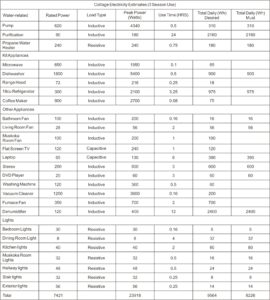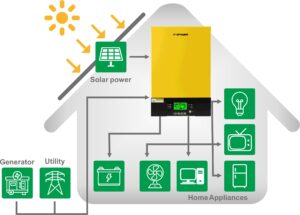Introduction
As an inverter manufacturer, every time we receive a call from a customer, in addition to asking about the price, the most frequently asked questions are, for example:
1、How to choose an inverter for an air conditioner, a TV, a computer, or a motor?
2、How to match the battery? How long can it be used?
Such common but difficult problems. Today, I have compiled a document for you to answer the above questions, hoping to be helpful to you.
Choosing the right inverter for your house is crucial to ensure uninterrupted power supply during outages. With various types and capacities available in the market, it can be overwhelming to make the right choice. However, with the right guidance, you can select an inverter that meets your household’s power requirements efficiently. This guide aims to simplify the selection process by providing valuable insights and tips on choosing the perfect inverter for your home.
Understanding Your Power Needs
Before diving into the world of inverters, it’s essential to assess your household’s power needs accurately. Determine the total wattage consumption of essential appliances and devices that you want to power during a blackout. Make a list of these items along with their power ratings in watts. This step will help you estimate the minimum capacity your inverter should have to support your basic electrical needs.
Assessing Appliance Power Requirements
Understanding the power requirements of your appliances is the first step in selecting the right inverter for your house. Consider the wattage ratings of essential appliances such as lights, fans, refrigerators, and electronic devices.
Are you unsure about the power consumption of your appliances? Don’t worry! Most appliances come with labels indicating their power consumption in watts. You can also use a wattage meter to measure the power usage of individual appliances accurately. But this is not enough to assessing appliance power requirements because some of appliances have an instantaneous peak power when this type of electrical appliances.
First, let’s describe the basic classification of electrical appliances and the features of different types of electrical appliances during use. Electrical appliances, in terms of technical performances, can be roughly divided into three categories:
1、Capacitive Electrical Appliances (Capacitive Loads)
2、Inductive Electrical Appliances (Inductive Loads)
3、Resistive Electrical Appliances (Resistive Loads)
Capacitive Load – Refers to the current flowing through the load leading the voltage. For example, TVs, Computers, Mobile phone chargers, etc. These are commonly used in households and are powered by switching power suppliers which can be called capacitive loads, because the first input stage of such electrical appliances has a large filter capacitor. For those who understand electronics, as we all know, capacitors are pass alternating current (AC) and block direct current (DC), but the capacitor current is 90 degrees ahead of the voltage, which means that it is a short-circuited wire relative to the power supply at an instant. Therefore, there is an instantaneous peak value in this type of electrical appliances when they start up to work.
Inductive Load – Refers to the voltage leading the current. Common ones we see are fans, speakers (which are usually powered by low-frequency transformers), water pumps, electric drills, air conditioners, and refrigerators. In relation to the power supply, what it connects to is an inductive coil, which is essentially an inductor. People who understand electronics know that the voltage across an inductor leads the current by 90 degrees. This means that, in relation to the power supply, when it’s initially turned on, it effectively creates a short circuit. Only after startup, when the impedance rises, does it stabilize and operate smoothly. When we use high-power electric motors, we can clearly feel that at startup, the lights and appliances throughout the house flicker. This phenomenon is due to peak power. The instantaneous peak power at startup can be many times greater than the rated power of the motor. For example, for a motor rated at 500W, with a startup peak power three times greater, the startup power would be equivalent to 1500W.
Resistive Load – For resistive loads, such as light bulbs, they are purely resistive relative to the power supply. There are no startup surge issues.
From the explanation above, when choosing an inverter, it’s important to understand the surge capacity of electrical appliances during startup. Surge impacts are typically seen in inductive or capacitive loads. For motor-type appliances, since they are inductive, the surge is generally between 3 to 7 times the rated power. For example, a 500W motor might have a surge power between 1500W to 3500W. inverters typically have a peak value of 2 times their rated power. So, for a 500W inverter, it can momentarily output 1000W, for a 1000W inverter, it can output 2000W, for a 1500W inverter, it can output 3000W, and for a 2000W inverter, it can output 4000W momentarily. Therefore, for a 500W motor, it’s recommended to choose an inverter with a rating of 2000W or higher. However, it’s important to note that not all motors have a surge capacity of 7 times their rated power. The key takeaway is that inverters can momentarily output twice their rated power, while capacitive or inductive loads may require 3 to 7 times their peak power during startup.
Determining whether it’s a 3-times or 7-times peak value isn’t difficult. It’s typically 3 times during unloaded operation and 7 times during full loaded operation. So, based on the degree of load on the motor, we can judge the peak value. For example, with a drill, we usually operate it under no load before drilling, so we can consider it as 4 times the peak value (it’s 3 times, the extra 1 is a safety margin). For a 500W drill, with a 4 times peak value, it would be 2000W, so a 1000W inverter would suffice. Similarly, for other electric motors. For an air conditioner, being purely inductive, the startup peak value is significant because the compressor works at full load each time it starts. We can consider its startup to be 7 times the peak value. For a 1000W air conditioner, with a peak value of 7000W, and considering the inverter’s 2 times peak value, 7000 divided by 2 equals 3500W. this means for a 1000W air conditioner, an inverter with a power rating of at least 3500W is needed for startup. Nowadays, air conditioners come equipped with inverters, so we can consider a 4 times peak value. For a 1000W inverter air conditioner, with a 4000W peak value, we would need an inverter of at least 2000W for safe operation. Therefore, for a 1000W air conditioner, we can choose an inverter with a rating between 1500W to 2000W.
Theoretical explanations may not be easily understandable for many customers, and even those capable of understanding may not necessarily want to delve into the details. Below, I’ll list the recommended inverter power ratings from some commonly used appliances:
1、Light Bulbs (Incandescent or LED): No special considerations needed; standard inverters should suffice. Fox example, 100W LED light bulbs require 120W or 150W inverter. (100/0.9=111. So 120W inverter is safe to use)
2、Refrigerator:Typically, choose an inverter with a power rating at least 2-3 times higher than the refrigerator’s rated power.
3、Electric Drill:An inverter with a power rating at least 2-3 times higher than the drill’s power rating should be adequate. For example, a 500W drill would have a peak value of 1500W, so it should be paired with an 800W inverter which has 2 times peak power. Similarly, for a 1500W drill, a 3000W inverter would be suitable.
4、Air Conditioner (Non-Inverter):For non-inverter air conditioners, select an inverter with a power rating at least 3-7 times higher than the air conditioner’s rated power, depending on the load and startup characteristics.
5、Air Conditioner (Inverter):For inverter air conditioners, choose an inverter with a power rating at least 2-4 times higher than the air conditioner’s rated power, considering the startup surge.
6、Vacuum Cleaner:An inverter with a power rating at least 2-3 times higher than the vacuum cleaner’s power rating should be suffice.
7、Washing Machine:Choose an inverter with a power rating at least 2-3 times higher than the washing machine’s rated power.
8、Microwave Oven:An inverter with a power rating at least 2-3 times higher than the microwave oven’s power rating should be suitable.
9、Television: For standard televisions, standard inverters should suffice. However, for large-screen televisions or those with high power consumption, consider an inverter with a power rating at least 2-3 times higher than the television’s rated power.
10、Desktop Computer:An inverter with a power rating at least 2-3 times higher than the computer’s power rating should be adequate.
11、Water Pump:For a household water pumps, choose an inverter with a power rating at least 3-7 times higher than the water pump’s rated power, considering the startup surge. For a water pump rated at 500W, considering a 7 times peak value, since it needs to start pumping immediately upon startup, thus having a larger peak value, with a peak value of 3500W, it should be paired with an inverter rated at least 1800W. (An inverter has 2 times peak power). For a 750W water pump, it should be paired with an inverter rated at least 2500W for safe operation.
It’s important to note that these are general recommendations, and the actual power requirements may vary based on specific models and usage patterns.
Let’s see how to calculate the duration of inverter usage. The formula for the duration of inverter usage is as follows:
Duration of battery operation = Battery capacity (in ampere-hours) x Battery voltage x 80% x 0.9 ÷ Load power
For example, using a 100W light bulb with a 12V 100Ah battery:
= 100*12*80%*0.9/100 = 8.64 hours
(Note: The actual usage time may vary due to factors such as battery quality, age, and condition. However, if you’re using a new battery that’s fully charged, it should approximately match the calculated duration.)
Calculating Total Wattage
Once you have a list of appliances and their respective power ratings, calculate the total wattage consumption by summing up the power ratings of all appliances. This total wattage will help you determine the minimum capacity your inverter should have to meet your household’s power needs during outages.
There is a household, and their electricity usage is as follows in the table below.

This house total wattage is 7,421W and the peak power is 23,918W. The total daily consumption of power is 9,564Wh and must daily consumption is 8,226Wh.
Types of Inverters
Inverters come in various types, each designed for specific application and preferences. Understanding the different types of inverters will help you make an informed decision based on your requirements.
Sine Wave Inverters: Sine wave inverters produce electricity that closely resembles the power from the grid, making them ideal for powering sensitive electronic devices such as computers and medical equipment.
Modified Sine Wave Inverters: Modified sine wave inverters are more affordable but may produce slightly distorted power output, which can affect the performance of certain appliances. They are suitable for basic electrical devices but may not be compatible with sensitive electronics.
Grid-Tie Inverters: Grid-tie inverters are designed to work in conjunction with grid power. They convert DC electricity generated by solar panels or wind turbines into AC power that can be fed back into the grid or used to power your home.
Off-Grid Inverters: Off-grid inverters are independent power systems that are not connected to the utility grid. They are commonly used in remote areas where access to the grid is limited or unavailable. Off-grid inverters are often paired with batteries for energy storage.
Factors to Consider When Choosing an Inverter
Selecting the right inverter involves considering various factors to ensure optimal performance and compatibility with your household’s needs. Here are some essential factors to keep in mind:
Capacity: The inverter’s capacity, measured in watts, should match, or exceed the total wattage consumption of your essential appliances. Choosing an inverter with insufficient capacity can lead to overload and potential damage to the appliances.
Battery Compatibility: If you’re opting for a battery-based inverter system, ensure compatibility between the inverter and the battery bank. Different inverters are designed to work with specific types and capacities of batteries, so it’s essential to choose compatible components for seamless integration.
Waveform type: Consider the waveform type generated by the inverter and its compatibility with your appliances. Sensitive electronic devices may require a pure sine wave output for optimal performance and safety.
Efficiency: Look for inverters with high efficiency ratings to minimize energy losses during the conversion process. A more efficient inverter will help reduce energy costs and prolong battery life.
Additional Features: Evaluate the additional features offered by the inverter, such as built-in surge protection, battery charging capabilities, and monitoring systems. These features can enhance the functionality and performance of the inverter system.
Budget: Set a realistic budget for your inverter purchase, considering both the initial investment and long-term operating costs. While quality inverters may come at a higher price, they often offer better reliability and performance, leading to cost saving in the long run.
By following these steps and considering key factors, you can select an inverter that meets your household’s power needs and ensures reliable backup power during outages.
For the cottage example, we can choose the inverters and the battery below:
1、Inverter capacity: Foxpower Low Frequency inverter charger 8kW 48Vdc model, this model has 3 times peak power (24kW peak power). This inverter charger can meet the normal power requirement and peak power requirement.
2、Four 12V 220Ah Lead acid batteries. The total energy is 12*4*220=10,560Wh. Meet the energy requirement of 9,564Wh.
FAQs:
1、What is the difference between a pure sine wave and a modified sine wave inverter?
A pure sine wave inverter produces electricity that closely resembles the smooth, undulating waveform of grid power, making it ideal for sensitive electronic devices. In contrast, a modified sine wave inverter generates a stepped waveform that may not be compatible with certain appliances, leading to reduced performance or potential damage.
2、Can I connect my inverter directly to my home’s electrical wiring?
No, it’s not recommended to connect an inverter directly to your home’s electrical wiring without proper safety precautions and professional installation. Inverter systems should be installed and configured by qualified electricians to ensure compliance with local regulations and standards.
3、How long can an inverter power my household appliances during a blackout?
The backup power duration provided by an inverter depends on various factors, including the inverter’s capacity, battery capacity, and the power consumption of connected appliances. In general, larger capacity inverter paired with high-capacity batteries can provide longer backup power durations compared to smaller systems.
4、What maintenance is required for an inverter system?
Regular maintenance is essential to ensure the optimal performance and longevity of an inverter system. This may include periodic inspections, cleaning of components, battery maintenance (if applicable), and software updates. It’s recommended to follow the manufacturer’s guidelines and consult with qualified professionals for maintenance tasks.
5、Can I use a solar inverter without solar panels?
Yes, you can use a solar inverter without solar panels by connecting it to a battery bank or other DC power sources. However, keep in mind that solar inverters are specifically designed to convert DC electricity generated by solar panels into usable AC power, so their efficiency and performance may vary when used with other power sources.
6、How can I troubleshoot common issues with my inverter system?
If you encounter any issues with your inverter system, such as power fluctuations, alarms, or malfunctions, refer to the manufacturer’s documentation for troubleshooting steps and guidelines. In some cases, simple troubleshooting procedures such as checking connections, resetting the inverter, or inspecting batteries may resolve common issues. If the problem persists, contact a qualified technician for assistance.
Conclusion
Selecting the right inverter for your house is a crucial decision that requires careful consideration of your household’s power needs, preferences, and budget. By assessing your power requirements, understanding the different types of inverters, and considering key factors such as capacity, compatibility, and efficiency, you can choose an inverter that ensures reliable backup power during outages. Remember to follow safety guidelines and consult with professionals for installation and maintenance to maximize the performance and longevity of your inverter system.








